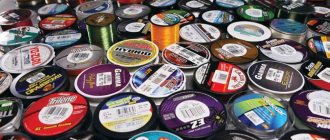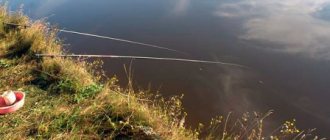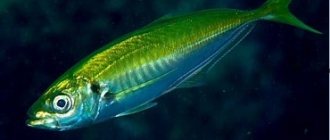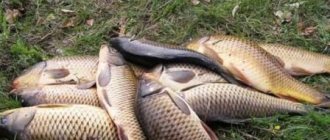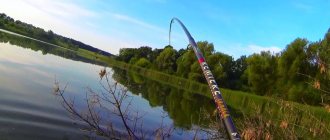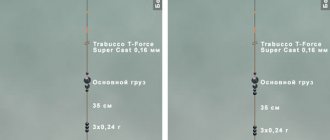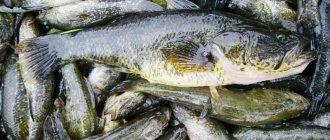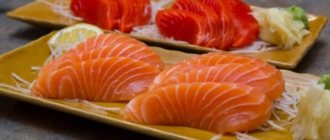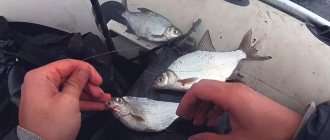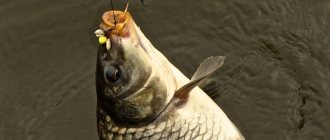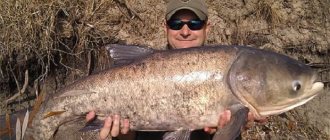Fishing gear is a set of fishing equipment designed for a specific method of fishing. Fishing gear includes: rods, reels, fishing line, sinkers, hooks and many other accessories.
The most popular fishing methods are: float, feeder, pickerel, spinning, fly fishing and trolling. Each of these methods has its own unique set of fishing gear.
The success of fishing largely depends on the correct choice of gear, which is selected taking into account the type of fish to be caught, the type of reservoir, the experience and personal preferences of the fisherman.
In our publication we will talk about how people catch fish today, what methods are most popular, and what elements each type of fishing gear consists of. A novice fisherman will be able to create a list of what is necessary for a particular type of fishing and make the right choice when shopping.
Float rod
The float rod is the most common fishing tackle in our country. Most fishermen began to learn the basics of fishing from fishing with float tackle. Float tackle consists of a rod, fishing line, float, sinker and hook. The rod can be equipped with a reel (Bolognese or match rod), or the rod can be without a reel (fly or plug rod).
Over the many years of existence of float fishing gear, several improved varieties have been formed, designed for different fishing conditions.
- A fly rod
is a lightweight rod without a reel or guides. The rod is made of fiberglass or carbon fiber and folds like a telescope. The fly rod is very light, usually its weight does not exceed 100 grams. The length of the rod can be from 2 to 8 meters. The line is attached to the tip of the rod. The fly rod is very mobile and ideal for quickly catching small fish. - The Bolognese fishing rod
is a telescopic rod 4-7 meters long, equipped with a reel and guide rings. The Bolognese fishing rod is designed for catching larger fish and has the ability to cast over a longer distance. - A match fishing rod
is a durable fishing rod consisting of 3 legs with a plug connection. The rod is equipped with an increased number of guide rings, a longer handle and is equipped with a spinning reel. The match fishing rod is designed for long-distance fishing with a sliding float. Suitable for experienced fishermen. - Plug fishing rod
is a special type of float fishing rod. A plug rod can have a length from 8 to 15 meters; the individual parts of the rod are connected to each other by a plug connection. While fishing, the angler can shorten or lengthen the rod as needed. A special feature of a plug rod is that when fishing for caught fish, the rod does not rise up, but moves back towards the shore. The plug rod is intended for experienced fishermen and is not suitable for beginners to master float fishing.
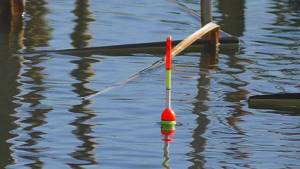
Each angler decides for himself which type of float gear to choose, taking into account specific fishing conditions and personal preferences. For beginner anglers, the fly and Bolognese fishing rods are best. For light fishing for small fish, a fly rod is ideal. If an angler wants more versatility, needs to make longer casts and be able to catch larger fish, then he should choose a Bolognese rod.
The optimal rod length for a float rod is from 4 to 5.5 meters. With such a rod it is easier to fish near the shore with hanging tree crowns, it is easier to cast and pull a fish or float out of the water. Longer rods (longer than 6 meters) are too bulky, difficult to control and do not provide any advantage to the angler.
For fishing with a float rod, on those types of gear where this is provided, spinning reels are installed. The coil size should not be too large, 1000-1500 will be quite enough. The friction brake on a reel for float fishing can be either front or rear. The number of bearings is preferably 5 or more. A metal spool is required.
For float fishing, monofilament fishing line is used. The diameter of the fishing line should be from 0.12 to 0.25 mm and depends on the fish you are going to catch. Smaller diameter fishing lines are suitable for catching bleak, roach, rudd, and small crucian carp. Lines of larger diameters are used for catching larger crucians and carp.
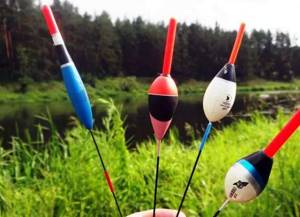
Float fishing is impossible without a float. Floats differ from each other in the following parameters:
- The volume of the float body
should not be too large or too small. - Elongation of the float body
- novice fishermen are recommended to fish with floats that have a more elongated shape; they are easier to load correctly and floats of this type behave less twitchily. - The length of the antenna
- the antenna is the brightly colored six at the top of the float, depends on the preferences of the angler. - The thickness of the antenna
depends on the preference of the fisherman. - The antenna can be replaced with an antenna of a different color
- with such a float it is convenient to fish at different times of the day. - The thickness of the keel of the float
- the keel is the lower part of the float; the thicker the keel, the less likely it is to break and the better the cambric that secures the fishing line will stick to it. - The presence of a ring in the upper part of the float body
- a float with a ring is more stable and the line will get tangled less.
The choice of a specific float model depends on the strength of the wind and the presence of current in the fishing area. In windy conditions and strong currents, use a larger, barrel-shaped float. When there is no wind and when fishing in still water, use a smaller float with a more elongated shape.
When fishing with a float rod, lead weights, which are cut lead pellets, are used to load the float. The sinkers are clamped onto the fishing line, thereby plunging the large float under the water, leaving only the bright antenna or part of it above the water. Packs of sinkers of different sizes and weights can be purchased at any fishing store.

The correct float tackle includes a leash, which is a thin piece of fishing line tied between the main fishing line and the hook. As a leader, you can use either a piece of monofilament line or fluorocarbon fishing line. When using monofilament as a leash, it should be 0.05 mm thinner than the main fishing line. When using fluorocarbon fishing line as a leader, its diameter should be equal to the diameter of the main fishing line.

A fishing hook is attached to the end of the leash. The size of the hook is selected depending on the mouth size of the fish you are going to catch and the type of bait you are using. There is a Russian and international hook numbering system. For crucian carp and roach you should use hooks 10-12 according to international numbering. For bleak and rudd, hooks numbered 14-16 according to international numbering are best suited. For perch and carp, use larger hooks 8-10 according to international numbering. According to international numbering: the larger the hook, the lower its number. In the Russian system it’s the other way around.
You may be interested in: Spinning for pike
Fishing rods
Needed for float fishing. Structurally they resemble spinning rods, but they are lighter and simpler in shape. Can be used with or without coils. To increase fishing efficiency, you need to choose the right equipment for each type of fishing rod: fishing line, float, type of weight and hook.

Common types of fishing rods:
- Bolognese. Size - from 4 to 7 meters, used in fishing in slow currents or in standing water. Hard models are designed for long casts, while soft ones respond better to small fish biting.
- Fly feathers. They are characterized by minimal weight with a maximum length of up to 8 m. The design does not provide rings for fishing line, and there is also no possibility of installing a reel. The area of application of this fishing equipment is fishing by hand. Their equipment is replaced quickly due to its simplicity.
- Match. Needed for long casts, characterized by large mass. Fishing gear of this type consists of three parts. A special feature is the use of a sinking fishing line. Maximum length – up to 5.5 m.
Fishing for pike perch: choosing tackle, bait and fishing location
When choosing, you need to take into account the rigidity of the rod and the correct selection of fishing line. Telescopic models can be equipped with various types of reels.
Feeder
A feeder is a fishing tackle designed for catching fish in the bottom layer of a reservoir. When fishing with a feeder, the angler throws the equipment with the feeder at the same point in order to create a feeding spot that will attract a wide variety of fish.
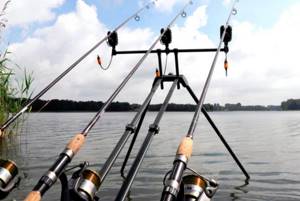
With the help of such fishing equipment as a feeder, you can catch a wide variety of peaceful fish: bream, silver bream, roach, ide, crucian carp, carp and carp. Sometimes predatory fish species, such as pike perch, are caught on the feeder.
Feeder gear consists of: a feeder rod, a spinning reel, fishing line and feeder equipment, which includes a feeder weight, hooks, leashes and connecting elements.
Most feeder rods have a length of 3.3 to 4.2 meters, with a test weight of 60 to 200 grams. The feeder rod consists of three main parts and a tip. When choosing a feeder rod test, an angler should consider what body of water he plans to fish on. For fishing in large reservoirs and rivers with strong currents, you should use a feeder with a dough of up to 200 grams, and sometimes more. For fishing in reservoirs with standing water, you can use a feeder with a dough of up to 60 grams.

To equip feeder rods, spinning reels are used, most often with a rear drag. When fishing on a feeder, reels with a baitrunner are often used. A baitrunner is a special switch at the back of spinning carp reels, which opens and closes the quiet exit of the line from the spool. For feeder fishing, spinning reels of sizes 2500, 3000, 3500 and 4000 are used.
For feeder fishing, both monofilament and braided fishing lines are used. When fishing at a distance of up to 25 meters from the shore, you can use monofilament fishing line. At a distance from the shore of 50 meters or more, it is better to use braided fishing line; it stretches less when tensioned and has better sensitivity.
When fishing with a feeder, anglers use a shock leader, which is a piece of thicker fishing line up to 10-15 meters long. A shock leader is needed as protection against breakage of feeder feeders during a sharp cast.
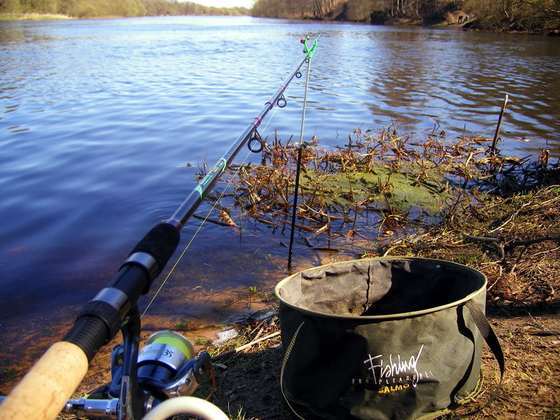
The hooks in the feeder are tied to special leashes made of thin monofilament or fluorocarbon fishing line. When using fluorocarbon leaders, the diameter of the leader is 0.05 mm thicker than the diameter of the main line, and when using a leader made of monofilament line, the diameter of the leader is 0.05 mm thinner than the diameter of the main line.
Feeder rigs are different methods of attaching hooks and feeder feeders to the main fishing line. Feeder feeders come in closed and open types, plastic and metal, with and without lugs, for groundbait and for animal bait. The shapes of feeder feeders are: cylindrical, rectangular, triangular, cone-shaped, flat with arcs for holding food, in the form of a wicker bag and in the form of a spring. Feeders are often lost during the fishing process, so fishermen buy 5-10 feeders of different types and different weights at once. The most famous types of feeder equipment: installation with an anti-twist, paternoster, in-line, symmetrical and asymmetrical loop, helicopter. The choice of a specific type of installation depends on the fishing conditions, the presence and strength of the current.
DIY "Helicopter"
“Helicopter” is one of the types of winter fishing gear that you can make with your own hands from scrap materials. This thing is made of metal.

A metal can of canned food or drink is perfect for the role of the main material for production.
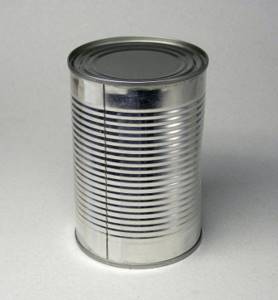
This type of tackle consists of a metal pinwheel, long and short wires with hooks, a locking ring, a sinker, a fishing line and a lock. With this bait you can fish all winter and get a good catch.
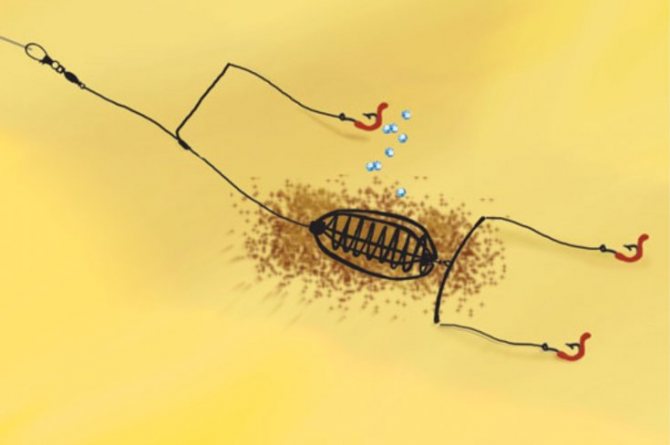
Picker
A picker is a smaller version of a feeder. The picker is designed for catching small fish in difficult casting conditions. Can be used for catching crucian carp, roach, rudd, silver bream, bleak and white bream.
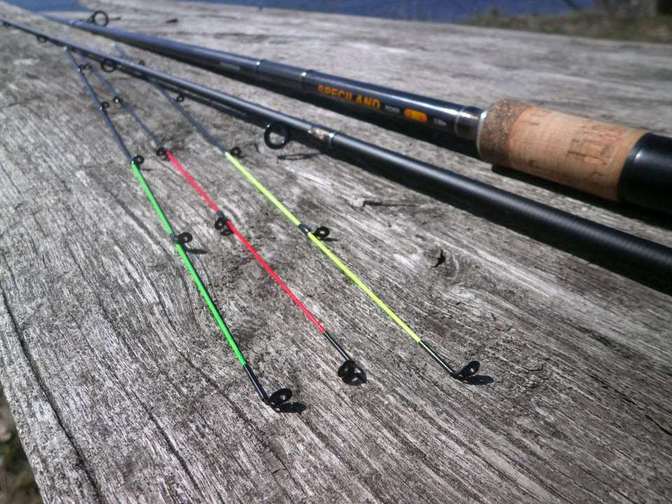
Picker rods have a length from 2.1 to 3.3 meters, weight up to 50 grams, the action is most often parabolic. The parabolic action allows the rod to bend along its entire length, which provides high sensitivity and makes it possible to feel the presence of even a very small fish on the hook. A picker rod consists of two main legs and a tip, in contrast to a feeder rod, which consists of three main parts and a tip.
When fishing with pickerel, the feeder is used only for the initial feeding of the fishing site. In the future, when the fish approaches the desired area, the feeder is not used, replacing it with an ordinary lead sinker. This method of using the feeder makes pickerel a more effective method of fishing, since the feeder scares the fish that come up for bait with its splash when it is thrown into the water. Many fishermen, when fishing with pickerel, do not use a feeder at all, throwing the bait into the water with their hands.
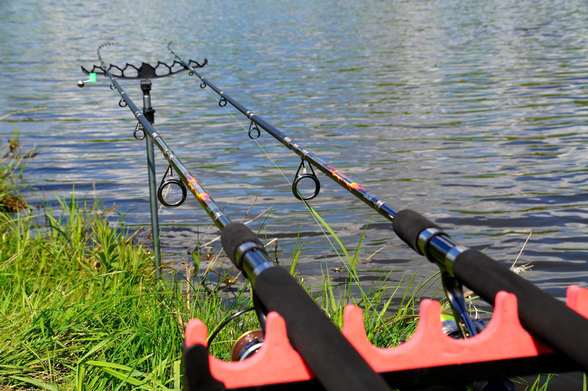
When fishing with pickerel, small spinning reels of sizes 2000, 2500 and 3000 are used. Monofilament line with a diameter of 0.14-0.20 mm is used as the main line. Leashes are made from fishing line with a diameter of 0.12-0.14 mm. For active fish, shorter leashes are used, for passive fish, longer ones.
Fishing with pickerel shows good results when fishing on lakes and river bays where there is no current. On rivers, pickerel can be successfully fished in the coastal zone, on the return rivers. In such places, the use of this fishing tackle gives excellent results that are difficult to beat using other fishing methods.
How to make a “garland” tackle?
“Garland” is used for simple fishing with any type of bait. Its essence lies in the fact that hooks for bait are attached to the fishing line in several places, at different levels.
- It is necessary to knit a garland without knots, as they can scare away the fish.
- As the knitting progresses, all hooks with bait are attached to the fishing line, except for the last one. The final hook is already attached to the line with a knot.
- There can be an unlimited number of baits on one line.
- To fish with a garland tackle, you will need a small fishing rod 15-20 centimeters long.
- The optimal fishing line diameter is 0.12-0.15 mm.
- “Garland” allows you to catch fish simultaneously at different depths and this is its undeniable advantage.
- On one type of tackle you can use different types of bait - bloodworms, jigs, spinners, and so on.
- This type of fishing is effective even during periods of significant decline in the bite.
- The tackle is easy to make with your own hands and easy to use.
- It is quite difficult to catch large species of fish with such bait.
- When biting is active, baits can interfere with each other and then the number of fish caught will decrease significantly.
- If you plan to move from one hole to another while fishing, then keep in mind that the longer the line, the more difficult it will be to carry.
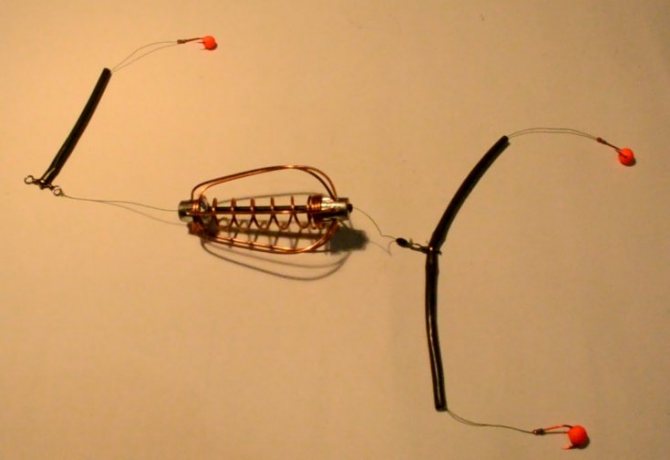
Spinning
Spinning is a method of fishing using artificial bait. Spinning fishing involves casting bait and retrieving it by rotating the handle of a spinning reel. The movement of the bait reminds the predator of a living object, which provokes it to attack. You can use a spinning rod to catch almost any predatory fish that lives in our reservoirs: pike, pike perch, perch, chub, asp, trout and even catfish; sometimes even peaceful fish species are caught with a spinning rod: carp and ide. Spinning fishing tackle consists of: a spinning rod, reel, fishing line and bait.
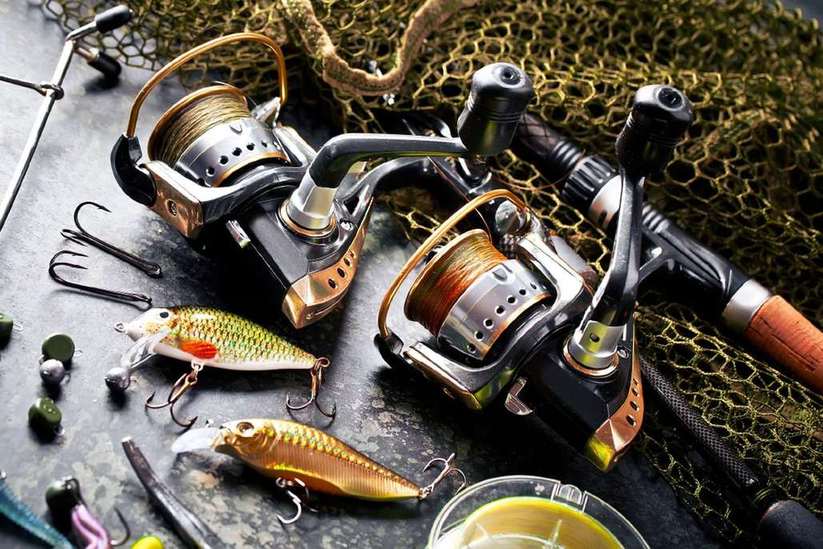
A spinning rod must be durable, light in weight, and provide high sensitivity. Modern spinning rods are made from carbon fiber, fiberglass and composite materials; the handle is polypropylene or cork. The rod is equipped with guides and a reel seat.
The spinning rod test is the manufacturer's recommended maximum and minimum weight for cast lures; the test can be indicated in grams or ounces.
The class of a spinning rod indicates its power; there are four main classes of spinning rods: ultra-light, light, medium and heavy.
You may be interested in: Trolling fishing
Spinning rod manufacturers produce spinning rods in a variety of sizes designed to catch a wide variety of fish in a variety of conditions. Most spinning rods have a length from 160 to 360 cm.
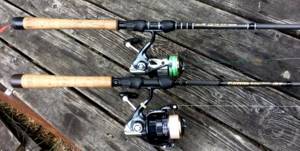
Spinning rods vary in construction. The casting range and sensitivity of the spinning rod depend on the system. Based on the action, there are spinning rods of super-fast, fast, medium and slow action.
The spinning rod is equipped with a reel. There are three types of spinning reels: spinning reels, inertia reels and multiplier reels.
The most popular type of spinning reel is the spinning reel. The appearance of a spinning reel is known to every fisherman; because of their appearance, such reels are often called “meat grinders” by fishermen.
A spinning reel consists of a spool, a line handle with a roller, a rotating rotor, a body containing the reel mechanism, a handle and a leg with which the reel is attached to the spinning reel seat. Spinning reels come with a front or rear friction brake.

Inertialess reels are easy to use, universal in terms of fishing method, thanks to a large number of models, they provide the fisherman with the opportunity to choose a reel that is suitable for fishing conditions and budget.
The fishing line is an important element of spinning tackle; it serves as a connecting link between the bait and the rod. There are three main types of fishing lines used in spinning rods: monofilament, braided fishing line (cords) and fluorocarbon fishing line. Most spinners use braided fishing line for fishing. Braided fishing line practically does not stretch; it transmits well any, even the most careful, touch of the fish to the bait.
When fishing with a spinning rod, anglers use a variety of types of baits: rotating and oscillating spoons, wobblers, silicone baits (twisters, vibrotails), spinnerbaits and mandules.

Rotating spoons are a metal petal rotating around a metal axis. With its rotation, the spinner attracts the attention of predatory fish and provokes it to attack. Rotating spoons differ in the size and shape of the petal, its color, and the weight of the spoon.
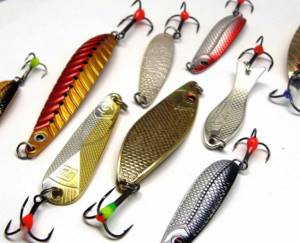
Oscillating spoons are curved metal plates of oval or elongated shape. The oscillating spoon imitates a fish fleeing from a predator pursuing it; with its play it provokes the predator to attack.
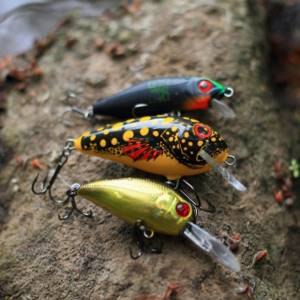
Wobblers are voluminous baits made of wood or plastic. With its play, the wobbler imitates a wounded, fleeing fish, which rolls from side to side, staggers and sways, provoking the predator to attack with its entire appearance and behavior. The body of the wobbler can be made of wood or plastic. According to their design, all wobblers are divided into bladed and bladeless. According to their shape, bladed wobblers are distinguished: minnow, shad, crank, fat. There are a large number of types of bladeless wobblers: poppers, walkers, gliders, jerkbaits, swimbaits, stickbaits, rattlins. Wobblers vary in degree of buoyancy into: floating, sinking and suspending. Wobblers also differ in several classes according to the degree of depth. The depth of the wobbler tells the angler how deep from the surface of the water the wobbler will be when the angler reels in the fishing line.

Silicone baits are made of elastic silicone, baits simulating insects, crustaceans, worms, fry and other food items for fish. Thanks to their elastic body, silicone baits wriggle beautifully in the water when retrieved, creating hydroacoustic vibrations and thereby attracting predators from a great distance. Silicone baits can be of different types in shape: twisters, vibrotails, octopuses, worms, crustaceans and others. For fishing, silicone baits are mounted on a jig head, on an offset hook or double with a Cheburashka weight, or using special spaced equipment, such as a drop shot or a retractable leash.
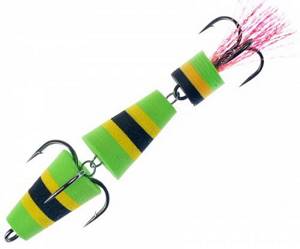
Mandula is a jig bait consisting of several polyurethane foam segments placed on treble hooks, which are connected to each other using winding rings. The mandula was originally invented for catching pike perch, but it turned out that it is also well suited for catching pike, perch and other fish.
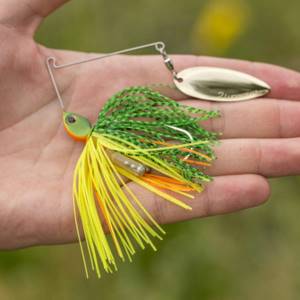
Spinnerbaits are an artificial fishing bait for catching predatory fish using a spinning rod; their design is a combination of a rotating spoon and a jig head. It was invented by American fishermen for catching bass, but our fishermen successfully use it for catching pike in overgrown areas of reservoirs.
Fly fishing
Fly fishing is a method of fishing with an artificial fly. Fly fishing equipment consists of: fly rod, reel, backing, fly line, leader, leader and fly.
Fly fishing rods are divided into one-handed and two-handed. The length of a one-handed fishing rod can be from 2 to 3 meters, the length of a two-handed fishing rod can be from 4 to 6 meters.
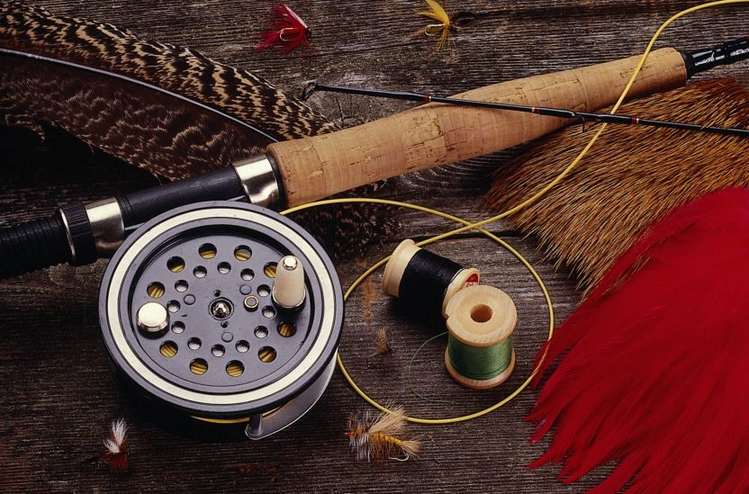
Fly fishing rods are divided into classes from 1 to 15. Previously, fly fishing rods were made of laminated bamboo and fiberglass, but nowadays most fishing rods are made of carbon fiber. Fly fishing rods are equipped with guides, a reel seat and a cork handle.
The fly reel is not involved in casting; it serves to store the line and to land the caught fish. Each fly reel has its own class, which must correspond to the class of the rod on which it is installed. Fly fishing reels come with two types of brakes: ratchet brakes and friction brakes. Reels with a ratchet brake are used with light class rods and are intended for catching small fish. Reels with a friction brake are used for catching large and strong trophy-sized fish. A powerful friction brake helps the angler to catch large and strong fish.

Backing is an extension cord that connects the fly line to the reel and is a thin twisted cord made of synthetic fibers. Backing is needed to lengthen the working length of the tackle in case of catching a large fish, which can completely pull off the entire line from the reel. Another function of backing is to increase the winding diameter so that the cord is located closer to the edge of the spool.
Fly fishing lines are divided into classes, from 1 to 15, corresponding to the classes of fly fishing rods. The class indicates the weight of the first 30 feet (9 meters) of the cord; for a class 1 cord this weight will be 4.3 grams, for a class 15 cord it will be 36.9 grams. Fly fishing lines are divided according to the degree of buoyancy into: floating, intermediate, sinking, floating lines with a sinking end. Fly fishing lines are divided into different types based on the geometry of the line. Many cord manufacturers directly indicate what type of fishing a given cord is intended for.
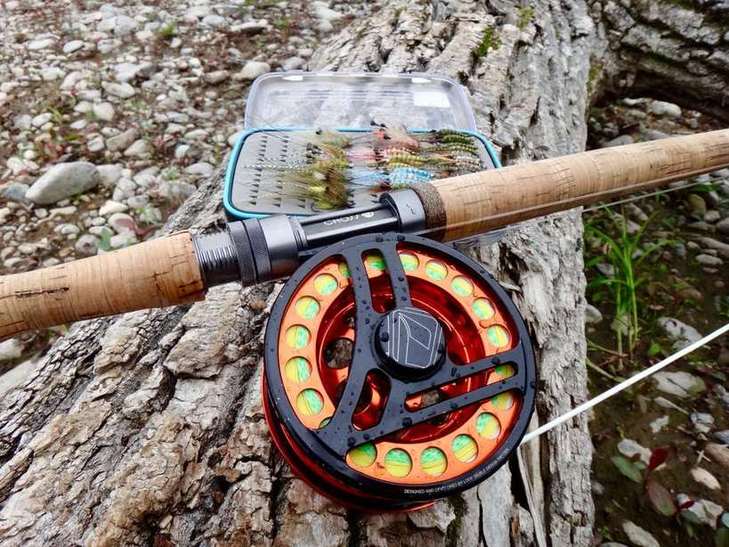
At the end of the fly cord, a leader is attached, which is a fishing line gradually decreasing in diameter. The undergrowth must transfer the energy of the unfolding cord to the leash with the fly and facilitate the correct smooth landing of the fly on the surface of the water. A leash is attached to the undergrowth, to which the fly is tied.
You may be interested in: Rockfish game and what it is eaten with
Fly fishing flies can be very different in size, materials used for their manufacture and degree of buoyancy. Flies are divided into: dry, wet, nymphs, emergers and streamers. Making fly fishing flies is an art and many fly fishermen are attracted not only by the fishing itself, but also by the opportunity to tie fly fishing flies themselves.
Trolling
Trolling is a method of fishing from a moving boat or motorboat. A similar method of fishing from a boat moving with oars is called track fishing.
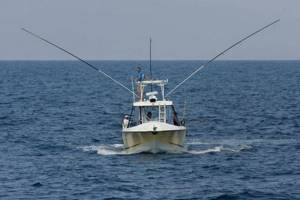
Trolling is used to catch fish in open water areas: seas, lakes, reservoirs, large and deep rivers. Trolling fishing is used to catch marine predatory fish: tuna, marlin, as well as freshwater predators: pike, catfish, pike perch, salmon.
A boat or motor boat intended for trolling is equipped with special holders designed for stationary installation of fishing rods. To measure depth and locate fish, most trolling boats are equipped with echo sounders. One vessel can be equipped with from two to ten trolling rods, each of which controls its own bait. Spinning rods for trolling are equipped with powerful multiplier or spinning reels.
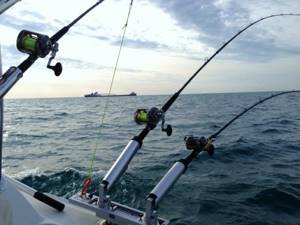
Deep-sea wobblers with a large blade are most often used as bait when trolling. Wobblers for trolling are selected with a certain immersion depth. To further deepen and move the bait away from the boat hull, special devices are used: downriggers, outriggers, sinkers and gliders.
When choosing fishing gear for trolling, the angler must take into account the speed of the boat, the type of predator that is intended to be caught, the depth of the fishing area and other characteristics of the reservoir in which the fishing is being carried out.
Donka
Donka is a fishing tackle designed for catching fish in the bottom layer of a reservoir. Donka can be considered a simplified, less sensitive and less athletic form of feeder.
The donka consists of a rod, reel, fishing line, sinker, leash and hook. For donkey use a rigid spinning rod, 3.0-3.3 meters long. An inertial or inertialess reel is installed on the rod, onto which a monofilament line with a diameter of 0.30-0.40 mm is wound. At the end of the main fishing line, tie a sinker and a leash made of thinner diameter fishing line with a hook. There can be several leashes and hooks. Since the rod used for donkeying is rough and does not have good sensitivity, a bite alarm is placed on its tip: bells or bells.

An even simpler version of the casting donk, in which the fishing line is wound on a reel and casting is done by hand. Donkeys are caught mainly in small rivers, not far from the shore. Donka-zakidushka is an ancient fishing tackle that our grandfathers and great-grandfathers used to catch fish, but which, when used competently and skillfully, is no less effective than a feeder.
When fishing with a bottom, the angler throws the bottom tackle into the water, sets the bite alarm and waits for the fish to sit on the hook under the weight of the sinker. Donk fishing is a passive fishing method and involves the use of self-hooking equipment.
The most popular equipment for fishing with a donk among fishermen is: makushatnik, crucian killer tackle, cork and nipple. They all have different devices, but the same principle of operation. The equipment consists of a feeder and several leashes with hooks on which foam balls are placed. When a fish approaches the bait, it begins to eat it, sucking it in and swallowing the hooks floating behind the foam balls. When jerking, the fish is caught on its own.
How to choose the right fishing tackle
To really enjoy fishing and boast of a big catch, you should choose the right gear to use. It is also necessary to carefully monitor the condition and quality of fishing rods in order to avoid possible breakdowns.
It is also important to decide what kind of fish will be hunted, as well as take into account the time of year and the type of reservoir. For beginners, a reel with a budget price is ideal; it must have a light handle.
For som
In most cases, when catching catfish, fishermen use bottom gear. They can be used both without a rod and with it. In the latter case, fishing rods are used both for fishing from a boat and from the shore.
How to catch more fish?
I have been active fishing for quite some time and have found many ways to improve the bite. And here are the most effective:
- Bite activator. Attracts fish in cold and warm water with the help of pheromones included in the composition and stimulates its appetite. It’s a pity that Rosprirodnadzor wants to impose a ban on its sale.
- More sensitive gear. Reviews and instructions for other types of gear can be found on the pages of my website.
- Lures using pheromones.
You can get the rest of the secrets of successful fishing for free by reading our other articles on the site.
When choosing a donkey, it is important first of all to pay attention to the quality, reliability and strength of the model.
For crucian carp
When fishing for crucian carp, all kinds of gear are used, the choice of which directly depends on the desired result, the type and characteristics of the reservoir, as well as the wishes of the fisherman himself. In most cases, a float rod is used. This is the most common method. Fishing is carried out using two techniques:
- Mast.
- Flywheel.
For silver carp
Today, among the carp family, the largest representative is the silver carp. It was its size and weight that made it so popular among fishermen. Until recently, it was believed that such fish could only be caught through poaching, but this is far from true.
It is worth noting that silver carp can grow up to 100 kilograms.

Nowadays, the fishing method using teknoplankton is very popular. This is a special bait, well compressed, which looks like a barrel.
When it is in water, it begins to gradually disintegrate, creating a cloud around itself, similar to natural plankton. The higher the quality of a given bait, the longer the dissolution process will be (often it can last from two to three hours).
You can easily purchase it at most fishing stores. In addition, you can try making bait yourself. Of course, there are quite a lot of recipes for making teknoplankton and they all have a number of features.
To make it you need:
- grind any cereal thoroughly to a powder, rice is often used;
- do the same with sunflower seeds;
- mix it all;
- add flavoring (honey, vanilla, cinnamon and other substances that have a pleasant smell).
To use this bait, you must have bottom tackle.
On the chub
In order to get a large catch of chub, the following gear is used:
- Fly feathers.
- Match.
- Bolognese.
Please note that when fishing with float rods, you should use bait.
Fly or Bolognese tackle involves the use of high quality floats that are resistant to strong currents. The shape of this device should be selected in accordance with the fishing conditions. Rounded models are often used.
Donka with rubber shock absorber
A donka with a rubber shock absorber is a wooden reel with the main fishing line wound on it. At the end of the fishing line there is an elastic band, to the end of which a weight is attached. Leashes with hooks are tied to the main line, closer to the elastic band, at a distance of 40-50 cm from each other. The optimal number of hooks is 5-7 pieces, although some greedy fishermen tie more of them, which ultimately has a bad effect on the final result.
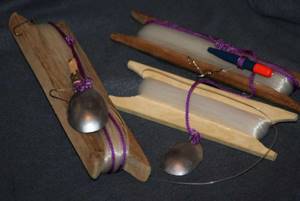
The donka is cast or brought in by boat once at the beginning of fishing; later, the angler pulls out the caught fish and changes the bait without pulling the load out of the water.
A donka with a rubber shock absorber has proven itself well when fishing on crucian ponds; it is not so convenient to fish with it on rivers, since the current pulls on the rubber and often tears the load out of place.
Mugs
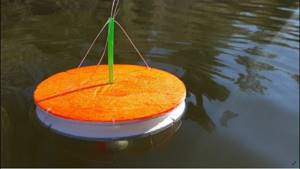
Mugs are fishing equipment for catching predatory fish with live bait. The circle is a disk made of foam plastic or wood with a diameter of about 10 cm and a thickness of about 3 cm. One side of the circle is painted in some bright color. There is a hole in the center of the circle into which a pin is inserted. The fishing line is wound around a circle, a leash is tied to the end, and a hook with bait bait is attached to it. Mugs are most often caught from a boat. The mugs can either be installed in a promising place in the reservoir, tied to reeds or snags, or allowed to float freely around the reservoir. Free-swimming mugs slowly drift across a body of water under the influence of current or wind and “look” for fish themselves. The fisherman must constantly monitor the circles without losing sight of them. As soon as the predator takes the bait, the circle turns over, signaling the angler about the bite. The fisherman swims on a boat to the triggered mug and pulls out the catch.
Meaning of the word tackle
tackle
for women (necessary, drug?) weapon, projectile, device, harness; tool, machine, and every part of it. Without gear there is an abyss. Thin tackle won't let you rest. The tailor has tackle: needle, thread, thimble, iron, etc. Tackle for forester, trapper: traps, traps, etc. Beaver tackle, old. all the harness for catching beavers (river). Fisherman's tackle: nets, nets, muzzles, seines, fishing rods, etc. Black tackle, self-catching, checker, balber, there are two of them: large or beam, for sturgeon, beluga, etc., and small, checker, for sterlet; first: a mainline (rope) with lines and forgings (hooks without notches and without bait); the mainline floats on balberkas, bunches (floats), with a float, a block, to indicate the location of the tackle; at the ends of the ridge there is a rope (rope) with a cat or a stone; the fish rubs as it passes and sits on the forgings; the small tackle is the same, but the mainline lies at the bottom, and the forgings are turned upward, and each one is supported by a checker or float. Khrebtin with the device, in a large one, I found; in shallow - overtightening. Ship's rigging, all ropes used for service, sea. rigging. Black and tarred, standing tackle, thickly tarred on the outside, serves to strengthen trees; white, running tackle, slightly tarred with tar, in hemp. According to the equipment, the horses were nobility. No shell, no tackle. Household equipment, utensils, junk, everything needed in a household's life. Without stocking up on gear, don’t expect sweets. There is gear for every animal. Without any gear, just catch fleas. You can't catch a lice without gear (you can't kill without a comb). Teeth are a wolf's tackle, but without them it can be an attack. | novg. rope, rope or snake. The latch is not a tackle, it is unreliable. | Natural parts, where the double rig comes from. Tackle, related to tackle. Tackle saw, casp. greenling, files, for forging points, bite hooks and black tackle. To rig, to rig, to equip, to equip, b. parts about ships, ships; arm, apply and carry out gear to control the vessel. The young sailor rigged the ships, singing. The merchant rigs the ship overseas, prepares it, sends it. -sya, to be rigged; | equip your ship. We'll get equipped and soon we'll go to sea. | Gear up, ugh. and be equipped with Novg.-Tikhv. (to equip?) to dress, to clean, to dress up. Equip the net for fishing. I rigged it up, just made a mess, it’s bad. Equip the ship. We got equipped and finished the work; equipped, finished the equipment. Retool again. To attach oneself to someone or something, to sit down, to stick. We took a long time to get ready. The ships are already being un-equipped. It was decorated with expensive stones. Equipment, equipment, action according to the verb. Rigger, rigger.Dahl's Dictionary
Deliveries

Postavushka is an ancient and very simple fishing tackle designed for bottom fishing of predatory fish with live bait. The set consists of a piece of strong fishing line, a sinker, a leash with a hook with live bait attached to it. The post is thrown by hand not far from the shore. When installing the hook, be sure to leave a loop of free line so that the predator does not feel resistance immediately after the bite. Typically, fishermen place several stands at once, maintaining a certain distance between them. The more supplies installed, the higher the chances of catching a predator. The other end of the fishing line from the supply is tied to trees or bushes. The best places to install stands are: clear water windows among water lilies, places near reed thickets, shallow waters with adjacent depths and other places where predators often live. You can fish with baits throughout the open water season from early spring to late autumn.
